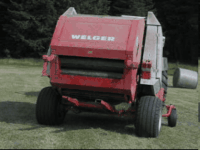| Agriculture |
|---|
 |
Agricultural equipment is any kind of machinery used on a farm to help with farming. The best-known example of this kind is the tractor.
Contents
- Tractor and power
- Soil cultivation
- Planting
- Fertilizers and pesticides dispenser
- Irrigation
- Produce sorter
- Harvesting / post-harvest processing
- Hand harvesting
- Hay making
- Hand hay tool
- Loading
- Milking
- Animal Feeding
- Other
- Obsolete farm machinery
- External links
















